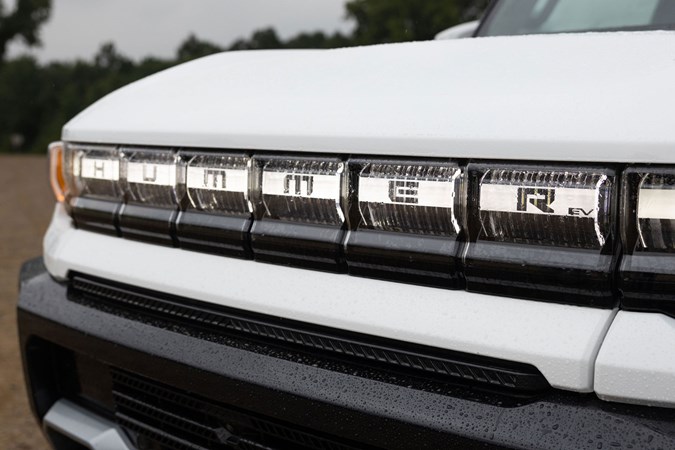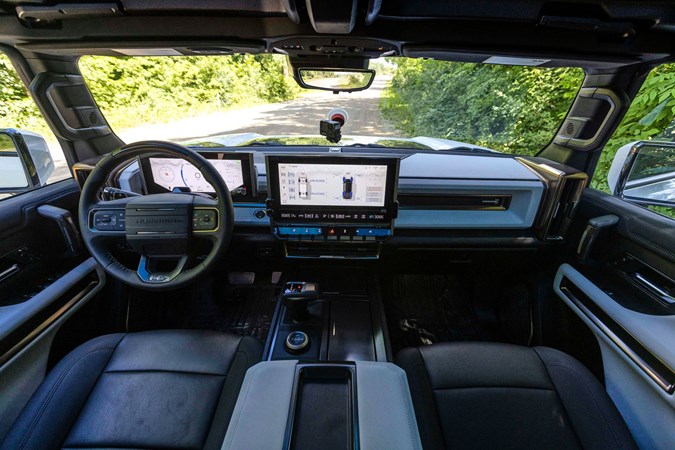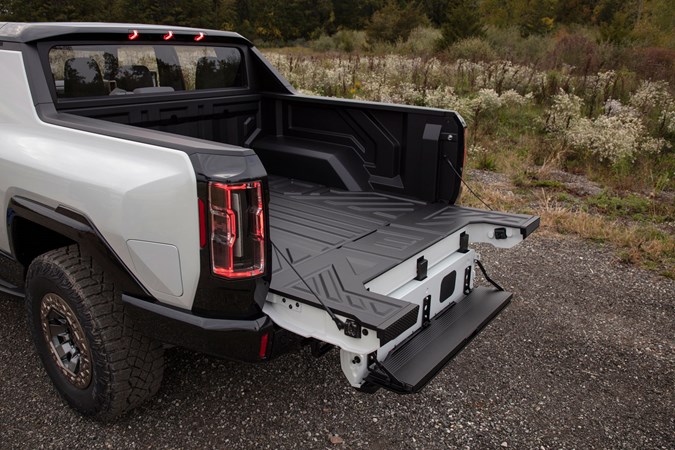Remember Hummer? Yes, we’re talking about the enormous American beast of an SUV that represented the worst of gas guzzling excess.
It was a victim of economic downturn in 2008, and eventually ceased to be in 2010 when a buyer couldn’t be found to rescue the financially stricken brand. But it seems that even the most indulgent of trucks can turn over a new leaf. Now, the brand is back – this time with the pure-electric GMC Hummer EV pickup.
Does this mean the Hummer is any less excessive? Absolutely not. It’s still huge, massively powerful and goes far beyond what is realistically necessary for an EV.

With all that in mind, we took the chance to get behind the wheel at General Motors’ huge Milford Proving Ground near Detroit to see how the massive numbers have impacted the driving experience.
Just how big is the Hummer EV?
Huge is doing it a disservice. It’s nearly 500mm longer, 150mm wider and 100mm taller than a full-size Range Rover – and that’s about as big as European cars normally get. More important is how much it weighs.
The Hummer EV tips the scales at more than four tonnes, which is way over the 3.5-tonne maximum permissible for any UK driver who passed their test after 1997. That pretty much rules out the Hummer’s hopes of heading to the UK in its current form.

Those who loved the previous Hummer’s in-your-face looks will be pleased with how this latest one measures up. The chunky styling helps it look as heavy, maybe even heavier than the numbers on the scales say.
There are H-shaped daytime running lights at either end of a glowing grille setup. There are tow hooks aplenty and you can take out the roof panels, much in the same way as you can with a Jeep Wrangler.

The Hummer also has something in common with the UK’s most famous van, the Ford Transit. Both the Hummer EV and the E-Transit are able to power external devices such as laptops and tools from external sockets. There’s also space under the bonnet for stashing them away from prying eyes.
The cabin will appeal to rugged outdoorsy types and urbanites alike, combining bronze metallic trim and two-tone upholstery with chunky switchgear and some clever storage bins.

A large, bright and clear display dominates the dash, with HD animations popping up when you cycle through the car’s various drivetrain settings. Normal mode shows the Hummer driving on the surface of the Moon, Offroad mode shows it on Mars, while the Tow/Haul mode shows it pulling the Saturn V rocket. There’s even a Watts to Freedom (and yes, that spells WTF) mode that allows the Hummer to deploy maximum torque.
Given that this is a pickup (and a heavy one at that), you would hope that it can carry a hefty payload. Sadly, that’s not the case. The bed is reasonably long at 1,520mm, but it can only support around 590kg which is inadequate by UK standards.

It’s also a long way short of the 1,000kg payload capacity required to qualify it as a commercial vehicle, and therefore be eligible for the tax breaks that make pickups so appealing to UK buyers.
What is the range and performance of the Hummer EV?
The main reason why the Hummer EV is so heavy is because it has an enormous battery pack. It consists of 24 modules and has more than 200kWh of capacity, for a maximum claimed range of more than 300 miles. It’s also compatible with 350kW DC fast chargers, which can add 100 miles of range in just 10 minutes.
The battery pack is mounted in GM’s new Ultium platform and sends power to three electric motors. There’s one to drive the front axle and one fixed to each rear wheel, giving the Hummer EV four-wheel drive and a maximum power output of 746kW.
That’s more than 1,000bhp in old money. Even more impressively, the system produces a staggering 11,500lb/ft of torque, which means this four-tonne SUV accelerates like a supercar. It’ll sprint from 0–60mph in around three seconds, which is roughly the same as a McLaren Artura or a Ferrari 296 GTB.

To make moving it around easier, the Hummer EV features rear-wheel steering. This also enables an unusual feature called Crab Walk. It lets the Hummer edge from side to side by steering the rear wheels in the same direction as the fronts, allowing it to side-step obstacles off road.
The car’s underside also features a load of protection panels, which prevent sharp obstacles such as rocks and branches from puncturing the battery pack.
What is the Hummer EV like to drive?
Our experience of the Hummer EV is relatively limited as we never ventured onto a proper road. All our driving was done off-road at the Milford Proving Ground. Despite this, we gained a real insight into the car’s capability as an exploration vehicle.
Even on a loose surface it can fly forward at an astonishing pace when you flatten the accelerator – and it does so with an artificial V8-like noise that matches the increase in speed. Nothing this large and heavy has any right being this fast. It’s almost as if the Hummer has read the laws of physics and then chucked the book in the bin.

At a corner – on loose gravel remember – there is a swooping amount of lift-off oversteer that arrives progressively as you turn. As we head onwards and make for a tighter, muddy track it would be nice if the brakes were a little sharper given everything they are dealing with. Granted, they might be a little more effective on tarmac though.
Through technical, rutted tracks, the suite of cameras dotted around the vehicle come to the fore. They give you a view of every possible angle around the Hummer – even showing you under the axles so you can avoid rocks. They are particularly helpful when you head up steep hills, where the huge bonnet prevents you from seeing much with your own eyes.
At one particularly steep climb, the Hummer’s off-road credentials were tested with its “B” mode on the shifter, which puts the vehicle into effectively a one-pedal mode. It will bring the car to a halt without needing the brake pedal. There are also switches for activating software within the electric motors to act like axle-lockers for better traction.

The car’s active air suspension can round off the edges of even the sharpest bumps. It has loads of travel, too, so you don’t need to worry about clattering the wheels into the arches when pushing hard.
All this impressive equipment makes driving the Hummer EV remarkably easy. The caveat here is that we didn’t share our space with other road users – the urban environment with its width restrictors, tight parking spots and fellow cars might prove a tougher challenge than the empty rutted test tracks we headed down.

How does Crab Walk work on the Hummer EV?
You engage Crab Walk by stopping the car, centring the wheel and holding the four-wheel steer button on the dashboard. An animated graphic will pop up on the centre screen if you’ve done everything correctly. Then, if you hold your hands at nine at three on the wheel, you only need to turn the steering halfway in either direction to make it work.
As a sensation, it’s utterly bizarre. Seeing the road ahead drift from side to side is unlike anything else you can experience in a car. Because it is designed for off-road work only it deactivates if you accelerate at any speed, with the rear steer going back into automatic mode. It’s a handy tool for dodging obstacles, though, and arguably makes the Hummer EV a more competent off-roader than something like a Defender.
GMC Hummer EV: verdict
Turning an EV into a huge, off-road focused monster is a very American thing to do – and, like a lot of American cars, we’re not convinced that it’ll work well in the UK. Size simply isn’t on its side.
As such, it’s highly unlikely that we’ll ever see the Hummer EV head to UK shores, at least through official channels. But importers soon started shipping the previous model across the Atlantic when the demand became evident – and we may see a similar pattern emerge with this new model.
Even then, the few cars that get the UK will probably be little more than promotional vehicles or weekend toys for the well-heeled. Businesses won’t get much use from the Hummer EV’s tiny payload and it’s high price will put it well out reach for most entrepreneurs. It’s expected to cost around £95,000 – and that’s before import fees.
It’s a technological marvel, though, serving a fantastic example of what GM’s new dedicated electric Ultium platform is capable of. And it’s remarkably easy to drive off-road, despite weighing the same as an average British town.
GM deployed a liberal “why not” attitude with the Hummer EV, and it is commendable to see the company jump into the electric future with such enthusiasm.
Just so you know, we may receive a commission or other compensation from the links on this website - read why you should trust us.






















